An Introduction to CFD Trading: Everything You Need to Know
Are you looking for an exciting and high-risk/high-reward investment opportunity? If so, then CFD trading might be just what you need. CFDs (or contracts for difference) are derivatives trading instruments that allow you to speculate on the price movements of a particular asset, such as commodities, currencies, stocks, and indices, without actually owning the underlying asset. In this blog post, we’ll provide you with a comprehensive guide to cfd trading, including how it works, its advantages and disadvantages, and some useful tips and tricks for beginners.
What is CFD Trading?
CFD trading enables traders to profit from the changes in the price of an underlying asset without owning the asset itself. Instead, you purchase a contract that represents an agreement between the buyer (you) and the seller (the CFD provider) to pay the difference in price between the opening and closing positions of the contract. As such, CFDs are called “derivatives” because they derive their value from the underlying asset. The appeal of CFD trading is that it allows you to trade with leverage, meaning that you can control a large position with a relatively small amount of capital.
Advantages of CFD Trading
One of the biggest advantages of CFD trading is the potential for high profits as you can make money regardless of whether the market is going up or down, as long as you correctly predict the price movements. Another advantage is the ability to trade a wide range of assets, including commodities, forex, stocks, and indices. Moreover, CFDs offer flexible trading options, such as short selling, hedging, and stop-loss orders, which enable you to personalize your trading strategy and manage risks.
Disadvantages of CFD Trading
Although CFD trading is highly profitable, it also involves significant risks. The underlying asset price volatility can lead to rapid losses, which is why you should always exercise caution and develop a risk management plan. Additionally, CFD trading fees can be high, including spread, overnight financing, and rollover costs, which can impact your profitability. Furthermore, the lack of regulatory oversight in some jurisdictions means that some CFD providers may be fraudulent or unreliable, so you should always choose a reputable and licensed broker.
Tips and Tricks for CFD Trading Beginners
If you’re new to CFD trading, here are a few tips to get started: Firstly, start small and trade with a demo account, which allows you to practice trading without risking your capital. Secondly, learn about technical and fundamental analysis, which are essential tools for predicting market trends. Thirdly, always have a risk management strategy in place, including stop-loss orders, to limit losses and manage risks. Finally, keep an eye on market trends and news that may impact the underlying asset price.
Conclusion:
CFD trading can be a lucrative and exciting financial instrument if done right. It offers traders the potential to profit from a wide range of assets with leverage, flexible trading strategies, and personalized risk management plans. However, it’s a double-edged sword where high profits come with significant risks that can quickly wipe out your account balance. Therefore, it’s essential to take your time to learn the ins and outs of CFD trading, practice with a demo account, and choose a reputable broker. With the right skills, knowledge, and strategy, CFD trading can be a profitable investment opportunity.
